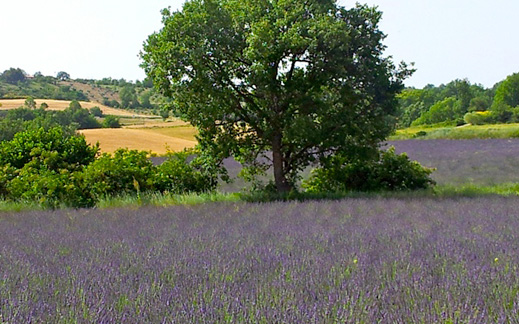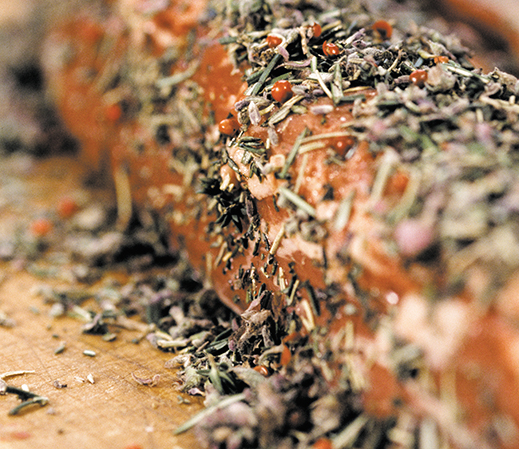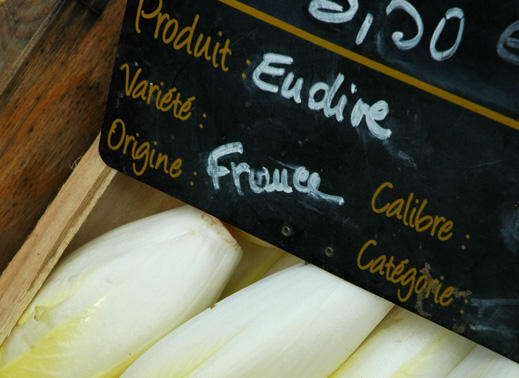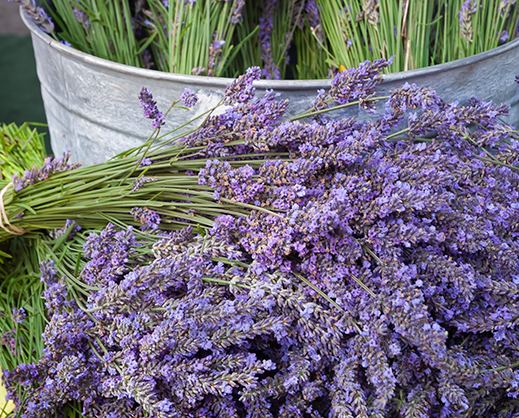
The golden containers of honey that sat on my grandparent’s breakfast table were scented with the wildflowers and lavender of the French Alps. The jars had a distinctive flower pot shape with the name of the ‘apiculteur’ (honey maker) italicized on the side. The honey’s rich flavor matched the deep flaxen color. My pleasure, each time I tasted it was undiminished. Just the aroma of that honey made me smile. I longed to discover where it came from.
I had always heard about the lavender fields of Provence that lay about two hours’ drive away but for myriad reasons each attempt to visit them had been thwarted. Finally many years later I drove on the meandering small roads of Provence, through the picturesque villages of Cotignac and Aups along the narrow D957, around the beautiful Lake of Ste. Croix, through Moustiers-Ste-Marie and up into the hills leading to the Plateau de Valensole in search of those images that had so mesmerized me. Could those fields of lavender really be around the next corner, or the next? The hint of their sweet aroma indicated that they could not be far away and then, upon the crest of a small hill I glimpsed an undulating wave of blue flowers cresting to the horizon. It was magnificent.
I stopped the car, switched off the engine and stepped out into the early July sun, luxuriating in the breathtaking scenery. Juxtaposed with the lavender fields were acres of golden wheat and tens of thousands of giant sunflowers, whose large orbs traced the arc of the sun in the sky. Here were Van Gogh’s paintings come to life. My daughter ran through the tall flowers, each one gazing down on her. The air was perfumed with a multitude of scents and the constant hum of foraging bees. About those bees .. we were suddenly aware of just how many bees surrounded us and decided to leave them to their work in peace. The odd one buzzed through one open window and out another in the car, legs coated with nectar. No wonder the honey tasted so good.
We stopped in one of the tiny villages on the oft windswept plane. A slightly battered signpost by the side of the road had ten different placards nailed to it indicating local perfume distilleries, lavender shops, soap makers, candle makers honey farms and lavender museums. The signpost a veritable illustration of lavender’s history and the many uses it has been put to.
Historical records indicate that the Egyptians and Phoenicians used it in their mummification process and in making perfumes. The Romans were responsible for its spread throughout Europe and England. They used it in their baths and for medicinal purposes. The word lavender stems from the Latin ‘lavare’, meaning to bathe. English lavender fields stem from these times. Roman soldiers took it on military campaigns for a variety of uses, including treating wounds. Indeed its healing properties were first recorded in 77AD by a Greek military physician named Dioscordes (who was employed by the Emperor Nero) in his extensive work ‘De Materia Medica. He spoke of its merits in treating skin and throat ailments, indigestion and headaches.
It was also extensively used as a perfume for rooms by brushing it over the floor, to fumigate treatment rooms for the ill, and has long been used as an antiseptic and anti-inflammatory. It is particularly soothing when treating burns and insect bites.
Fifteen hundred years later the plant was in high demand in Queen Elizabeth I’s court. She used lavender in many forms, from perfume to tea, the latter as a remedy for migraines. Lavender has since been used in everything from aromatherapy, soaps, and candles to detergents and medicine. During the First World War, lavender oil was used to dress wounds if medics ran short on antiseptics.
It was first brought to America by the pilgrims in the 1600’s and migrated with them as they crossed the country. California’s Mediterranean climate is particularly suited to the production of lavender, which brings me back to that honey.
Not long ago, strolling through the Santa Barbara farmer’s market I tasted some honey from San Marcus Farms. They have a raw, unfiltered local Wildflower Honey which is a transatlantic echo of the one I ate as I child. I stood with my eyes closed, my taste buds running a culinary film in my mind of honey’s past. I hope that they will have a lavender honey soon. In the mean time I used the honey with fresh lavender from my garden to make a glaze for a roast chicken, the aroma of Provence and the central coast all rolled into one.
It seems that old recipes containing the plant are common for jellies, preserves, desserts and sweets but its use as a culinary perfume of the savory kind is more recent. Over the last decade dishes with lavender have filtered through all parts of a three course meal. Any quick search on the internet will flood your screen with tasty treats filled with the blue flowers. It pairs well with citrus fruit and mint (it is part of the mint family), thyme and rosemary, hence its inclusion in Herbes de Provence. It’s wonderful paired with goat cheese and tastes marvelous with grilled meats and roasts. The more I cook with it, the more I appreciate the depth of flavor it can give a dish, although you have to be careful not to use too much. As with all perfumes, an excess of it can be overpowering, but used with a delicate hand, it is fragrant and enticing.
GOAT CHEESE SALAD
Serves 8 people
1 tablespoon mustard
¼ cup olive oil
1 tablespoon vinegar
4 oz. Mache greens
2 oz. mixed salad greens
1 tablespoon lavender flowers – finely chopped
1 tablespoon parsley – finely chopped
1 tablespoon chives – finely chopped
2 sprigs thyme – leaves removed and finely chopped
Zest of 1 lemon
4 oz. goat cheese log

ROASTED BEEF TENDERLOINS WITH A HERB AND LAVENDER CRUST
Serves 8 people
2 ½ - 3 lb beef tenderloin
Medium coarse salt
Freshly ground black pepper
2 tablespoons fresh lavender – finely chopped
1 tablespoon lemon thyme – roughly chopped
1 tablespoon chives – finely chopped
1 tablespoon oregano – finely chopped
2 tablespoons olive oil
1 tablespoon lavender honey
2 tablespoons butter

BRAISED ENDIVES
Serves 8 people
8 endives - halved
Olive oil
Butter
Salt and pepper

LAVENDER POTS DE CRÈME
Serves 8 people
2 ½ cups heavy whipping cream – do not use ultra-pasteurized cream as it will cause the pots de crème to separate
6 springs lavender flowers – coarsely chopped
5 ½ oz sugar (3/4 cup plus 1 tablespoon)
Just under 1/3 cup lemon juice
3 tablespoons lavender flowers – coarsely chopped